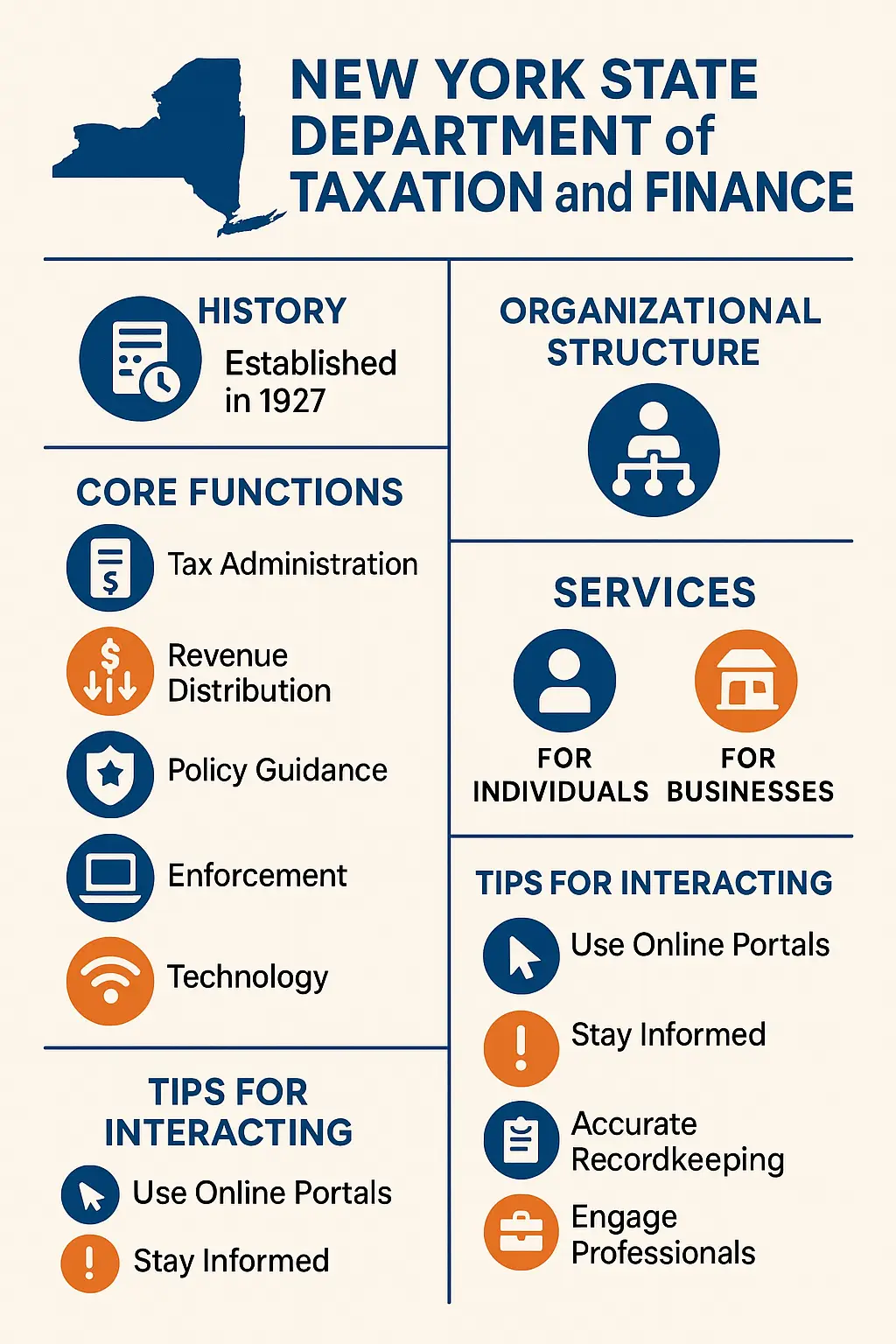Introduction
The New York State Department of Taxation and Finance (NYSDTF) is a key agency within New York State government charged with administering tax law, collecting revenue, and providing services and guidance to individuals, businesses, and tax professionals. Established in 1927, the department has grown to encompass a broad range of functions—from processing income tax returns to enforcing compliance and distributing revenue to local jurisdictions. Understanding NYSDTF’s history, structure, core responsibilities, and services helps taxpayers and stakeholders navigate obligations efficiently and leverage available resources. (en.wikipedia.org)
History and Formation
The NYSDTF was formally created on January 1, 1927, though its origins date back to efforts in the mid-19th century to devise formulas for distributing state-collected revenue to individual counties. Its inception centralized tax administration in New York State, aiming for uniformity and fairness in revenue allocation. Over time, the department’s remit expanded to encompass a wide array of tax types, modernized filing systems, and enforcement mechanisms. Notably, the department maintained operations through major events, including hosting offices in the World Trade Center during 9/11, with significant staff losses in its revenue crimes and mediation bureaus on that day. (en.wikipedia.org)
Organizational Structure and Governance
NYSDTF operates under the leadership of the Commissioner of Taxation and Finance, appointed by the governor. Its headquarters are located in the W. Averell Harriman State Office Building Campus in Albany. Internally, the department is organized into divisions responsible for areas such as personal income tax, corporation tax, sales and use tax, real property tax relief programs, tax policy and legislative affairs, tax law interpretation, customer services, and technology operations. An independent law enforcement arm, the New York State Office of Tax Enforcement (OTE), handles investigations into tax fraud, illicit trade, and revenue crimes. Regulations promulgated by NYSDTF appear in Title 20 of the New York Codes, Rules and Regulations. (en.wikipedia.org)
Core Functions
- Tax Administration and Collection: NYSDTF processes personal and business tax returns (e.g., individual income tax, corporate franchise tax, sales and use tax, withholding tax), issues refunds, and collects payments. It provides online filing and payment options, penalty and interest calculations, and installment agreements for taxpayers needing extended payment terms. (tax.ny.gov, en.wikipedia.org)
- Revenue Distribution: Collected revenues are allocated to state operations, education programs, infrastructure, and redistributed to localities per statutory formulas (such as through the STAR property tax relief program). The department ensures timely disbursement of credits and reimbursements to counties, school districts, and other entities. (en.wikipedia.org)
- Policy, Guidance, and Regulations: NYSDTF interprets tax law, issues guidance documents, forms, publications, and maintains up-to-date instructions for filing. It drafts proposed regulations, solicits public comment on rulemaking, and provides FAQs and instructional materials for taxpayers and tax professionals. (tax.ny.gov)
- Enforcement and Compliance: Through the Office of Tax Enforcement, the department conducts civil and criminal investigations into tax evasion, fraud in sales, alcohol, tobacco, petroleum sectors, and other revenue crimes. It works with state and federal law enforcement on cases affecting tax integrity. (en.wikipedia.org)
- Technology and Modernization: NYSDTF invests in online services (e-filing, Quick Pay, Web File for businesses), automated processing, and digital outreach to streamline taxpayer interactions. Online portals enable users to check refund status, respond to notices, and access calculators (penalty, estimated payments). (tax.ny.gov)
Services for Individuals and Businesses
- Individuals: The department provides an Income Tax Filing Resource Center, E-file options, refund tracking, online payment arrangements, and guidance on credits (e.g., STAR credit, inflation refund checks). Resources include “Respond to a Letter” portals for taxpayers receiving notices and checklists for documentation. (tax.ny.gov)
- Businesses: Services cover Sales and Use Tax registration and filing, Withholding Tax responsibilities, Corporation Tax returns, and other business-related taxes. Web File enables scheduling payments, updating business information, and accessing transaction history. Resources for tax professionals include registration, education, and posting requirements. (tax.ny.gov)
- Real Property and STAR Program: Through the STAR (School Tax Relief) program, NYSDTF administers property tax relief checks or exemptions for eligible homeowners. Online lookup tools inform applicants about delivery schedules and eligibility criteria. (tax.ny.gov)
Enforcement and Investigations
The Office of Tax Enforcement (OTE), as NYSDTF’s law enforcement division, is divided into bureaus such as the Petroleum, Alcohol and Tobacco Bureau (PATB) and the Revenue Crimes Bureau (recently renamed the Special Investigations Unit). OTE conducts investigations into fraudulent schemes, underreporting of tax liabilities, illicit trade operations, and collaborates with other agencies for complex cases. Enforcement actions may include audits, civil penalties, criminal prosecutions, and asset seizure when warranted. (en.wikipedia.org)
Recent Developments and Challenges
NYSDTF continually updates its online tools and resources. Recent enhancements include expanded online services for inflation refund checks, updated penalty and interest calculators, and improved taxpayer communications channels. The department also adapts to legislative changes—such as adjustments in tax rates, new credits, or procedural changes—by issuing guidance and updating forms promptly. Challenges include ensuring cybersecurity for taxpayer data, maintaining system reliability during peak filing periods, and responding to unusual events (e.g., service disruptions, legislative shifts in federal SALT treatment). (tax.ny.gov)
Public Engagement and Transparency
NYSDTF publishes press releases on major tax relief initiatives, guidance on new legislation, and notices about system updates or service changes. Taxpayers can subscribe to email alerts on topics like business tax tips or inflation refund checks. The department offers FAQs, webinars, and outreach to tax professionals to clarify complex rules. Transparency is supported through posting of regulations under review, opportunities for public comment, and publication of statistics and reports on revenue collections. (tax.ny.gov)
How Taxpayers Can Interact Effectively
- Use Online Portals: E-file returns, make payments via Quick Pay, check refund status, and respond to notices online to reduce delays. (tax.ny.gov)
- Stay Informed: Monitor NYSDTF announcements for legislative changes, new credits or relief programs, and system maintenance schedules. Subscribe to relevant email topics. (tax.ny.gov)
- Accurate Recordkeeping: Maintain documentation for deductions, credits, and compliance—use checklists provided for audits or inquiries. (tax.ny.gov)
- Engage Professionals When Needed: For complex filings, large-scale business tax matters, or enforcement inquiries, consult qualified tax professionals or legal counsel. (tax.ny.gov)
- Respond Promptly to Notices: If NYSDTF issues a letter or assessment, use the “Respond to a Letter” portal and provide requested documentation quickly to avoid penalties. (tax.ny.gov)
Conclusion
The New York State Department of Taxation and Finance plays an essential role in the fiscal health of the state by administering tax collections, distributing revenue, enforcing compliance, and providing taxpayer services. Its evolution from early revenue-distribution formulas to modern digital platforms reflects ongoing efforts to improve efficiency and transparency. By leveraging NYSDTF’s resources, staying abreast of policy updates, and adhering to filing and payment obligations, individuals and businesses can navigate New York State tax requirements effectively and contribute to the state’s financial stability. (en.wikipedia.org, tax.ny.gov)

